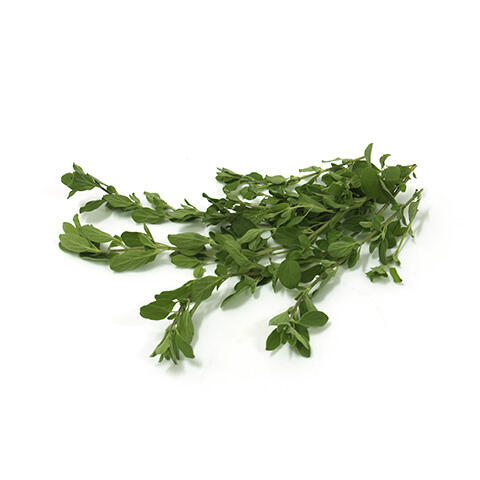You are here
Marjoram

Markon First Crop (MFC) Marjoram is related to oregano, but has a milder, sweeter flavor. Use in place of oregano; flavors meals for pennies per plate.

Product Details
Shelf Life:
Julian pack date.
Storage Temperature:
38°-42°F (4°-6°C)
Ethylene Producing:
No
Ethylene Sensitive:
Yes
Kosher:
No
Available Offerings from Markon for Marjoram
| Description | Net Weight | Pack | GTIN | UPC |
|---|---|---|---|---|
| Marjoram | .25 pounds or .12 kilograms | .25 LB | 0 06 11628 91987 4 | 6 11628 91987 4 |
| Marjoram | .50 pounds or .23 kilograms | .50 LB | 0 06 11628 91988 1 | 6 11628 91988 1 |
| Marjoram | 1 pounds or .45 kilograms | 1 LB | 0 06 11628 91989 8 | 6 11628 91989 8 |
Storage Tips:
Keep in original containers; store at proper temperatures; keep away from ethylene producing items.
Handling Tips:
Handle as little as possible to reduce bruising and premature spoilage; do not wash until ready to use. Rinse whole fruits and vegetables in clean running water prior to using.
General Usage Ideas
- Stuff sprigs of marjoram and sliced lemons under chicken roasters; bake with potatoes.
- Sauté mushrooms and marjoram; stir into risotto; top with sliced venison or duck breast.
Fall / Winter Usage Ideas:
- Add fresh corn kernels and MFC Marjoram to buttermilk cornbread
- Toss MFC Potatoes with minced MFC Marjoram, balsamic vinegar, and olive oil; roast until browned
- Season holiday turkeys with a mixture of MFC Marjoram, MFC Sage, and MFC Rosemary; stuff skin with butter, sliced MFC Lemons, RSS Peeled Garlic; roast and serve with mashed sweet potatoes
Spring / Summer Usage Ideas:
- Fill giant ravioli with shredded stone crab meat, white corn, halved cherry Tomatoes, and MFC Marjoram; boil, then sauté in butter; top with spicy jalapeno-cilantro sauce
- Stir chopped MFC Marjoram into beer batter; dip sliced MFC Eggplant, MFC Zucchini, and RSS Onion Rings; lightly fry and serve with garlicky aioli
- Pan-fry trout and RSS Peeled Garlic in butter and; season with RSS Lemon Juice and fresh MFC Marjoram; serve over steamed MFC Asparagus
Did You Know?
Herbs are one of the oldest agricultural products. Egyptian records from as early as 2800 B.C. mention their role in food, medicine, cosmetics, perfumes, dyes and magic.


